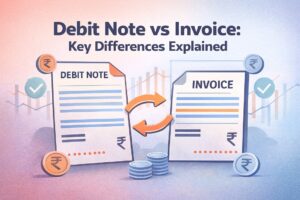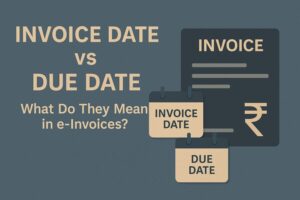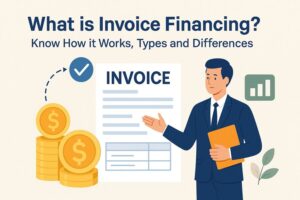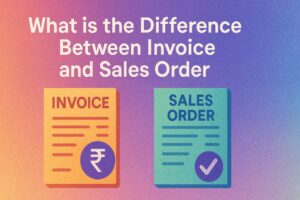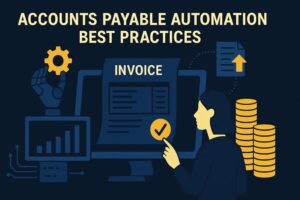4 Key Differences Between Revenue Recognition and Invoicing
- 21 Nov 25
- 7 mins

4 Key Differences Between Revenue Recognition and Invoicing
Key Takeaways
- The difference between revenue recognition and invoicing lies in timing. Revenue is recorded when earned, while invoices are issued when goods or services are delivered.
- Revenue recognition affects the income statement, whereas invoicing impacts accounts receivable on the balance sheet.
- Understanding the difference between revenue recognition and invoicing helps Indian businesses avoid mixing up billed amounts with actual earnings.
- Revenue recognition follows strict accounting principles (Ind AS), while invoicing follows GST-based compliance rules in India.
- Clear awareness of the difference between revenue recognition and invoicing ensures accurate financial reporting, better decisions, and compliance.
In India, several businesses mix up billing with actual earnings. That’s why knowing the difference between revenue recognition and invoicing is so important. While one shows money actually earned, the other shows money expected. Let us explore the key differences in this blog that set these two processes apart.
What is the Difference Between Revenue Recognition and Invoicing?

Revenue recognition and invoicing are often confused, but they serve distinct purposes. While invoicing is about billing for goods or services, revenue recognition records when that income is truly earned.
The table below provides 4 major difference between revenue recognition and invoicing:
| Factors | Revenue Recognition | Invoicing |
| Timing | Revenue recognition process happens when the income is actually received by the company (when it is earned).This recognition can be subject to:Transference of rewards and risks of ownershipReasonable measurement of revenue amount is possibleThe seller loses control of goods or services.Reasonable assurance of revenue collectionReasonable measurement of incurred cost can be done | Issuance of an invoice happens when the delivery of services or goods is made to the customer. This issuance is not subject to the ‘received’ nature of payment. |
| Purpose | Primary purpose of revenue recognition is to give a comprehensive view to any business regarding its expenses and earnings over a specific period of time.It also serves both the external and internal decision-makers to make informed decisions on subjects related to investing. | Primary purpose of invoicing is to request payment. Other purposes that it serves are as follows:To provide information regarding the goods or services, such as quantities, descriptions, and payment termsFor bookkeeping purposesTo serve as a legally recognised recordFor tracking the sales of a businessTo monitor paymentsTo help with tax filing, business analytics and inventory tracking |
| Impact on Financial Statement | It reflects on the income statement of a company as a part of their total earnings, which has the ability to affect profitability metrics such as net and gross profit. | Invoicing has a direct impact on the ‘accounts receivable’ part of the balance sheet. It represents the amount that a customer owes to a company. |
| Accounting Methods | The most common revenue recognition methods are as follows:Completed-Contract MethodSales-Basis MethodPercentage-of-Completion MethodCost-Recoverability MethodBrokerage Agreement MethodInstallment MethodAppreciation MethodAccrual MethodDeposit MethodProportional Performance MethodBill and Hold Method | Invoicing in accounting is carried out in various forms, such as: Standard invoicesPro forma invoicesDebit and credit notesRecurring invoices |
Example Highlighting the Difference Between Revenue Recognition and Invoicing
Imagine there is a media company named ‘XYZ’ with various revenue streams. One of their sources is providing subscriptions for their media platform. They use subscription billing model to manage their annual service of ₹2,400. A customer, Gaurav, gets the subscription with a ‘one-time payment’ in January 2025.
- Invoicing: This happens when the company generates a document depicting the service Gaurav has bought, and requests payment through that document.
Now, technically, Gaurav has transferred the whole amount of ₹2,400 to XYZ when he bought the subscription in January 2025. However, the complete ₹2,400 will not reflect in XYZ’s profits for January in 2025.
- Revenue Recognition: XYZ will divide up the amount and recognise only ₹200 each month (₹2,400 annually) as their revenue.
This will help create an even balance of revenue generation and maintain financial health for XYZ throughout the year.
Note: While revenue recognition apportionment may differ from invoicing requirements, the total customer billing value over the contract’s duration must match the total contract revenue recognition value.
What Is Revenue Recognition?

Revenue recognition is an accounting principle that specifies when and how to recognise the revenue of a company. This principle uses accrual accounting. For the world, the regulation for this principle is set by the International Accounting Standards Board.
In India, the revenue recognition rules are governed by the 41 Indian Accounting Standards (Ind AS).
The focus of revenue recognition is on the income statement of the period when there is realised and earned revenue. This does not include only the action and process of receiving cash or payment.
To be completely ‘realised’, the revenue-generating activity needs to be fully completed during the respective accounting period.
What Is Invoicing?
Invoicing is the process of creating an invoice. An invoice lists the goods or services sold and shows how much the customer needs to pay. It can be done either physically or electronically. In India, the GST regulations mandate the generation of e-invoices for most businesses.
From April 1, 2025, businesses with turnover over ₹10 crore must upload e-invoices to the GST portal within 30 days of the invoice date. No delays allowed beyond this window.
When to Issue an Invoice?
The generation of an invoice is under two conditions: for the supply of goods or professional services and raising a tax invoice.
- The seller can raise an invoice for the supply of goods as soon as the delivery of goods is complete. The usual credit period in this instance ranges up to 30 days from the invoice date.
- The seller can raise an invoice for rendering any kind of service on a monthly basis, which is by the end of each month. The usual credit period in this instance is also 30 days from the invoice date.
- For raising a tax invoice, a business needs to follow the GST laws in India. This is because there are separate time limits set for issuing the invoices for the supply of services and goods.
Invoice Governance in India
Certain governance rules in India regarding invoicing are as follows:
- Rule 46 of the CGST Rules mandates that an invoice must include specific compulsory fields.
- Since October 1, 2020, India shifted from voluntary to mandatory e-invoicing systems.
- A tax invoice serves as proof of supply for the supplier and plays a vital role in enabling the buyer/recipient to claim Input Tax Credit (ITC) under GST. Section 16 of the CGST Act clearly states that the recipient must possess an invoice to claim ITC.
- Customs authorities require both the packing list and the commercial invoice for processing.
Importance of Electronic Invoicing
Invoice software can electronically generate invoices that have the ability to automatically create a base for accounting of debtor’s or buyer’s accounts or account ledger creation.
Moreover, e-invoicing also helps in avoiding issues, such as errors due to manual data entry, missing accuracy checks, and complications from switching software.
💡Use the PICE App for smooth invoice generation for your business needs
Conclusion
Having a clear idea of the difference between revenue recognition and invoicing helps businesses maintain accurate financial records and comply with accounting standards.
While invoicing triggers payment requests, revenue recognition ensures earnings reflect true business performance. By managing both correctly, your company can avoid financial misstatements and make smarter, data-driven decisions for sustainable growth.
 By
By 





